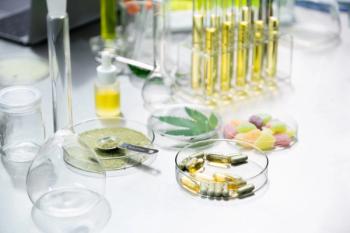
Cannabis Science and Technology
- September 2021
- Volume 4
- Issue 7
Laboratory Accreditation: Is It Enough to Guarantee Your Samples Are Analyzed Correctly?

The inter-laboratory variation problem still exists, which means laboratory certification is necessary, but not sufficient to guarantee your samples are analyzed properly. Here, Smith offers suggestions to help improve the situation.
As the cannabis industry evolves, more and more cannabis laboratory certification programs are popping up. However, work by myself and others clearly shows the ongoing inter-laboratory variation problem in this industry still exists, which means laboratory certification is a necessary, but not sufficient, condition to guarantee your samples are analyzed properly. Here, I offer suggestions to help improve the situation.
What is Laboratory Accreditation?
Laboratory accreditation is the process by which an ideally unbiased, independent 3rd party is used to certify the operations of laboratories, including cannabis analysis laboratories. Examples of entities providing this service include private companies (1), nonprofits (2,3), and of course state governments (4). The list in the references is not exhaustive, and one should perform an internet search or use other means if desiring to obtain laboratory accreditation.
The goal of most laboratory accreditation bodies is to get your laboratory to conform to what is called ISO 17025 standards (5). ISO stands for the International Organization for Standardization (6), who develop and publish international standards across a wide range of industries. The purpose of the ISO 17025 standard is for “General Requirements for the Competence of Calibration and Testing Labs” (5). The process of achieving ISO 17025 accreditation is a lengthy one and involves writing down standard operation procedures, establishing quality control procedures, validating and calibrating methods, and insuring management and technicians are properly trained amongst other things.
What is the role of the United States Federal government in accrediting cannabis analysis laboratories? The Food and Drug Administration (FDA) has issued some guidance on cannabidiol (CBD)-containing materials and has approved some CBD preparations for use as medicines (7). However, since materials with greater than 0.3 weight % total tetrahydrocannabinol (THC) are still illegal at the federal level, the FDA cannot legally regulate the production and testing of marijuana and its derivatives. The 2018 Farm Bill (8) and Final Rule (9) tasked the United States Department of Agriculture (USDA) with developing a testing program to determine if cannabis plant material is legal hemp, that is 0.3% total THC or below, or illegal marijuana. The USDA in turn has asked each state to submit proposals as to how testing laboratories in that state will be operated and regulated. From my own discussions with USDA management and scientists, they have made it crystal clear that they do not accredit any specific laboratories or analysis methods, again all they do is approve state programs. Federal law does require hemp analysis laboratories to be registered with the United States Drug Enforcement Agency (DEA) (10). However, this does not mean DEA evaluates and accredits laboratories. All DEA registration means is that a laboratory has filed the paperwork and has proven that they store, use, and account for controlled substances properly. The United States National Institute of Standards and Technology (NIST) (11) is another government agency involved in promulgating standard reference materials and methods that aid in laboratory calibration and validation work. NIST is in the process of working on standard reference materials for cannabis analysis (12). However, again since marijuana is illegal at the Federal level this means they are emphasizing hemp standards over marijuana. At the end of the day then, there is no United States Federal government agency actively involved in accrediting cannabis analysis laboratories.
Are Specific Cannabis Analyzers or Methods Accredited?
As some of you know my day job is as CEO and Chief Technical Officer of Big Sur Scientific, who manufacture and sell a mid-infrared spectroscopy-based analyzer (13). A question I am frequently asked by potential customers is if the FDA, DEA, or USDA have “certified” the analyzer. To the best of my knowledge, no government agency certifies specific makes and models of analyzers. In the pharmaceutical industry, the FDA will review methods for analysis of specific analytes in specific matrices, for example, the measurement of the amount of acetylsalicylic acid (the active pharmaceutical ingredient or API) in an aspirin tablet by high pressure liquid chromatography (HPLC). The FDA has in its employ technical experts who will read through methods and carefully go over calibration and validation data. If a method is found lacking, the FDA has the power to force companies to improve their analytical methods until they pass muster, can prevent a medicine from being approved, and can even shut down manufacturing if they believe a poor analytical method is putting the public at risk. If the FDA accepts a method, this is not a blanket acceptance of a specific analyzer or analyzer technology, it only means this method is fit for purpose, that is, for the analysis of a specific analyte in a specific matrix. Thus, the acceptance by the FDA for an HPLC assay for the amount of acetylsalicylic acid in aspirin does not mean they have certified HPLC generally or the make and model of a chromatography system being used.
I have had in person discussions with USDA technical staff about hemp analysis methods. They have made it crystal clear that the USDA does not analyze hemp and they do not certify hemp analyzers or hemp analysis methods. Again, they leave it up to state governments to generate testing plans that they will then approve. The USDA’s final rule on hemp testing (10) does contain the words “gas chromatography” and “liquid chromatography,” however these are only mentioned as examples of methods that are in use. By no means does Federal law require that you use chromatography to analyze hemp.
The FDA cannot legally regulate the marijuana side of the cannabis industry and seems to be taking a wait and see attitude (to a point) on regulating hemp and CBD. The USDA and DEA are not in the business of certifying cannabis analyzers or methods. Thus, like laboratory accreditation, there is no federal government agency overseeing the overall quality of cannabis testing.
At the moment, it is state governments that bear the brunt of regulating cannabis laboratories and analytical methods. I can’t possibly review all of them here because there are 50 different states with 50 different sets of regulations. My reading of them is that in general most states require cannabis laboratories to obtain ISO 17205 certification, and the state may request that other requirements be met as well. The problem here of course is lack of uniformity. The same cannabis bud may be determined legal in one state but not another and this, of course, is not fair. There needs to be comprehensive regulation of the cannabis industry at the federal level, but that is grist for another column.
What Can Laboratory Accreditation Do for the Cannabis Industry?
In a perfect world laboratory accreditation means that there will be a written procedure for everything a laboratory does. This means there need to be standard operating procedures (SOPs) for everything from choosing and vetting analyzers, sample preparation, calibrating and validating instruments, training technicians, and management best practices. There are even SOPs for amending SOPs. As part of the laboratory accreditation process laboratories are required to produce all these SOPs, show where they are stored and how they are accessed, and show that these procedures make sense and are in use.
Ideally, all this paperwork ensures that qualified analysts use calibrated and validated analyzers to perform analyses in a standard, reproducible way yielding accurate and precise measurements. Now, accrediting bodies also do not bless specific analyzers or analysis technologies. Like the FDA, if a specific method passes their muster, it is acceptable to for use by that laboratory in that specific analysis. This says nothing about whether the same analyzer or technology will work well at any other laboratory, or in any other application.
Ideally, if laboratories are accredited, such as with ISO 17205 certification, they should get the same results on the same samples. In other industries we insure this by having standard reference materials of known composition analyzed by many laboratories in a round robin fashion. Laboratories that meet some acceptable level of accuracy and precision on these samples are good to go. Those laboratories that do not pass these tests can lose accreditation unless they improve.
In non-cannabis industries standard reference materials are frequently provided by NIST (11). However, again NIST reference standards for our industry do not yet exist, and ones for marijuana or its extracts and distillates may never exist unless current federal law changes. This means it is difficult to compare results across cannabis laboratories because we do not have a full suite of standard reference materials for doing so.
The Reality: Inter-Laboratory Variation Is Still with Us
Others and I have researched and written extensively on the inter-laboratory variation problem in cannabis analysis (14–19). Briefly, the problem is that different laboratories consistently get different results on the same samples. As an example, I draw your attention to one of my own papers, which I believe was the first peer-reviewed paper published in Cannabis Science and Technology (14). In that work, we took a batch of marijuana distillate, known to be pesticide free from multiple analyses, and spiked it with known amounts of six different pesticides. We then submitted these samples in duplicate to five ISO 17205 certified, state licensed laboratories in California. The false negative rate, that is the percentage of the time pesticide was present, but the laboratories said it wasn’t, was 78% (14). The results are seen in Table I (14).
These results are appalling, and mean the public is being poisoned by cannabis products containing illegal amounts of pesticides.
In the same study we submitted the same batch of marijuana extract in duplicate to the five laboratories for cannabinoid profiles. The THC values for these samples obtained varied widely as seen in Table II (14).
The measured concentrations of THC varied from 77.83% to 94.46%, a range of over 16 wt.%. The distillate was a simple sample, contained a high amount of analyte, thus the wide spread in values should not have been observed. What the five laboratories had in common is that they all measured the THC values by HPLC.
Mid-infrared (IR) analysis of the same samples gave a much narrower spread of values as seen in Table III (14).
Note that the data range here is 4.52 wt.% THC, indicating that the distillate sample was homogeneous. This means the wide spread of THC values as measured by HPLC seen in Table II was not due to the sample, but real variations amongst the laboratories. We also concluded that since the spread in the HPLC data is 3.7 times greater than for mid-IR, that mid-IR is more precise for distillate analysis than HPLC (14).
Remember, all of these laboratories were licensed and accredited. Why did we get such variable results? Shouldn’t ISO 17205 and other accreditations protect us from results like this. In theory yes, but in reality, they don’t for several reasons:
- For true laboratory-to-laboratory standardization we need not only pure solutions of cannabinoids or pesticides in solvent, we need what NIST calls matrix reference materials (MRMs). These are actual cannabis biomass, extract, and distillate materials with known amounts of analytes in them. The importance of matrix reference materials is that it allows us to test how sample extraction affects results. Analyzing a solution of pure molecules skips the actual sample extraction process and thus tells us nothing about it. As I have pointed out before, we do not yet have a good set of MRMs for cannabis laboratories to use, and hence no way to compare results from different laboratories to promote standardization (15,16). This is why I recommend never comparing results from different cannabis analysis laboratories.
- Just because a laboratory has an SOP does not mean it will be used. Just because a laboratory has an SOP does not mean that for a given analysis the analyst will follow the SOP correctly. People make mistakes, and in the absence of constant supervision it is impossible to eliminate them.
- I have been involved in several laboratory certification and audit processes. My observation is that the people sent to perform the certification or audit process, though they are definitely smart and mean well, are generally not experienced analytical chemists. These people can ensure that all required SOPs exist on paper, that they are in a correct format and readily available. That is, these people can make sure a laboratory has SOPs, but they are not capable of ascertaining whether those SOPs are scientifically sound. For example, ISO 17205 certification does not guarantee that a laboratory extracts cannabis biomass correctly, or that all laboratories do it the same way, it just certifies that a specific laboratory has a written extraction procedure in place. Until people with better qualifications are hired for laboratory accreditation, inter-laboratory variation will continue to be a problem.
At the end of the day then, laboratory accreditation is necessary but given the current state of the industry it is not sufficient to guarantee all customers will get precise and accurate results.
An Interim Solution
We need more and better matrix reference materials and laboratory accreditors. Until that happens, what should we do? Let’s restrict our discussion to cannabinoid analysis by HPLC. In each state, for example, in California, the state government should vet HPLC methods until they have a method they trust, which we will call the “golden method.” They then should insist that all chromatographs in that state use this golden method, and make each laboratory prove that its chromatographs get the same results as the golden method. This will tide us over until the bigger problems outlined above are solved.
Conclusions
Cannabis laboratory accreditation programs exist and require cannabis laboratories to have written SOPs. The federal government has done little to accredit laboratories, and state governments vary as to how they do things. Ideally, laboratory accreditation means customers will obtain precise and accurate data, and that different laboratories will get the same results on the same samples. The reality is that inter-laboratory variation is still with us and has several causes including a lack of matrix reference materials and the use of accreditors who are not experienced analytical chemists. Until these problems are solved, adoption by states and accrediting bodies of a “golden” method may suffice.
References
- ISO 17025 Accreditation Process (pjlabs.com).
- Cannabis Laboratory Testing Accreditation Program | A2LA.
- ANAB Laboratory Accreditation (ansi.org).
- Testing laboratories - Department of Cannabis Control.
- ISO - ISO/IEC 17025:2017 - General requirements for the competence of testing and calibration laboratories.
- ISO - International Organization for Standardization.
- FDA and Cannabis: Research and Drug Approval Process | FDA.
- 115th United States Congress, Senate Bill S.2667,” Hemp Farming Act of 2018.
- Federal Register: Establishment of a Domestic Hemp Production Program.
- Hemp Analytical Testing Laboratories | Agricultural Marketing Service (usda.gov).
- National Institute of Standards and Technology | NIST.
- NIST Tools for Cannabis Laboratory Quality Assurance | NIST.
www.bigsurscientific.com .- B.C. Smith, P. Lessard, and R. Pearson, Cannabis Science and Technology 2(1), 48 (2019).
- B.C. Smith, Cannabis Science and Technology 2(2), 12-17 (2019).
- B.C. Smith, Cannabis Science and Technology 2(3), 10-14 (2019).
- M.O. Bonn-Miller, M.J. E. Loflin, B.F. Thomas, J.P. Marcu, Travis Hyke, and R. Vandrey, JAMA, J. Am. Med. Assoc. 318, 1708 (2017).
- B. Young, The Seattle Times, January 5, 2016.
https://www.seattletimes.com/seattle-news/marijuana/some-pot-labs-in-state-failed-no-pot-at-all-says-scientist . https://www.nbcbayarea.com/investigations/Industry-Insiders-Warn-of-Fraud-at-Marijuana-Testing-Labs-458125743.html?_osource=SocialFlowFB_BAYBrand .
ABOUT THE COLUMNIST
Brian C. SMITH, PHD, is Founder, CEO, and Chief Technical Officer of Big Sur Scientific. He is the inventor of the BSS series of patented mid-infrared based cannabis analyzers. Dr. Smith has done pioneering research and published numerous peer-reviewed papers on the application of mid-infrared spectroscopy to cannabis analysis, and sits on the editorial board of Cannabis Science and Technology. He has worked as a laboratory director for a cannabis extractor, as an analytical chemist for Waters Associates and PerkinElmer, and as an analytical instrument salesperson. He has more than 30 years of experience in chemical analysis and has written three books on the subject. Dr. Smith earned his PhD on physical chemistry from Dartmouth College.
Direct correspondence to:
How to Cite this Article
B.C. Smith, Cannabis Science and Technology 4(7), 8-11 (2021).
Articles in this issue
over 4 years ago
Cannabis and Hemp Tableting Challengesover 4 years ago
Does Light Spectrum Alter Plant Transpiration Rates?Newsletter
Unlock the latest breakthroughs in cannabis science—subscribe now to get expert insights, research, and industry updates delivered to your inbox.



